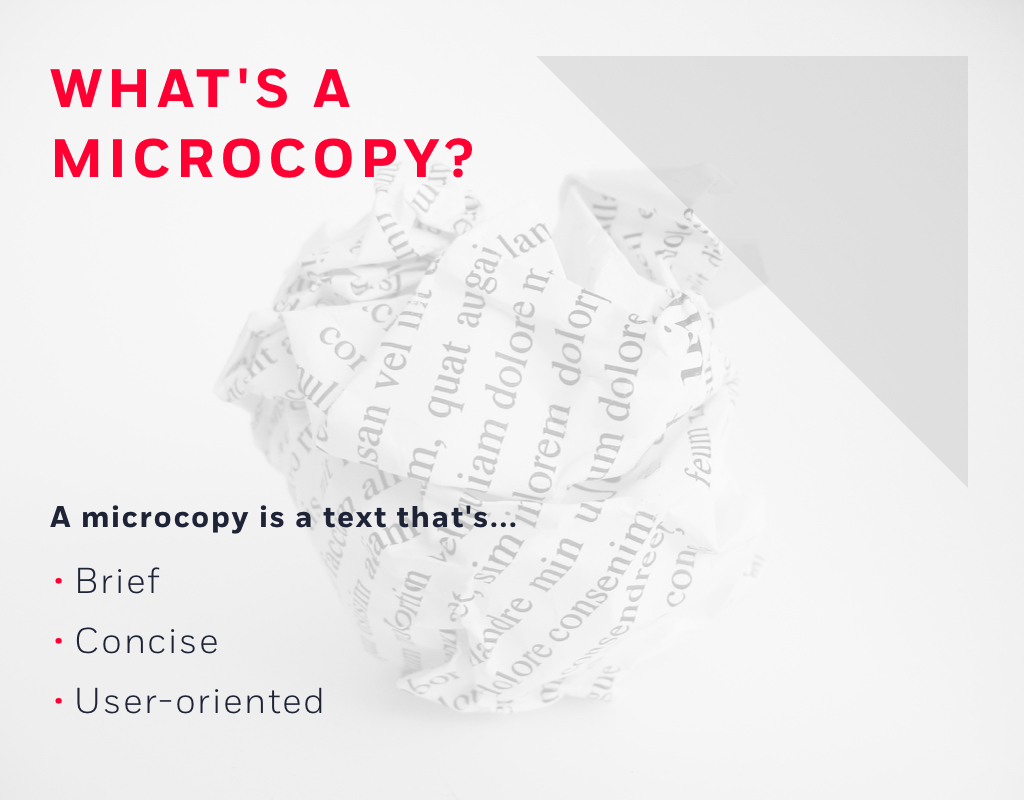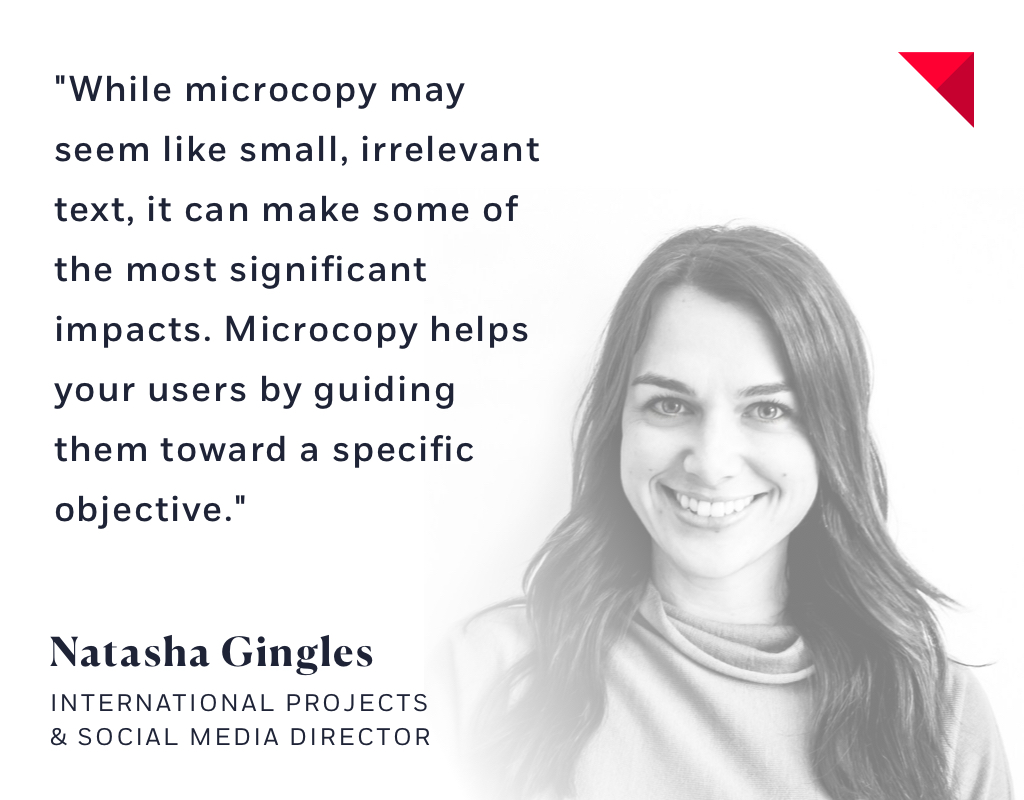An Introduction to Microcopies from Different Perspectives

Using words appropriately, as well as adapting them to the context and those expressing them has turned into an imperative. Marketing messaging is becoming increasingly more thought-out and focused on subtly drawing consumers’ attention and touching their heartstrings. This is where microcopy emerges.
What’s a microcopy?

In their book, A Pocket Guide to the Craft of Words, Christopher Murphy and Nicklas Persson explain that a microcopy: “Is the craft of words on a micro level, considering the way in which words can satisfy a functional requirement by helping and improving interactions with design, improving interfaces for both functioning and delight, and helping a user in their journey.”
In other words, they’re smaller texts that guide the user experience through a website app, email, and more. Every piece, regardless of its size, has to consider the user's context and the brand’s tone to create a useful, brief, and concise combination.

A microcopy example is a text that highlights the benefit of a product or service for a user. Instead of merely saying “Subscribe,” an example would be “Access exclusive content.” Or, to put it concretely, we can see how Airbnb quickly and easily reminds a potential guest that if they click the "Continue" button, they won't be charged. They're texts that help users and make their experience that much better.
Microcopies’ goals

1. Increase conversion
A website's primary goal is ensuring a user carries out a specific action, whether it be subscribing to a newsletter (as we saw before) or purchasing a product. Words help them find that path and perform the action we want them to carry out.
2. Foster trust
Every text is also essential to ensure the user trusts what they're seeing or doing. If it's well-explained, there won't be any doubts.
3. Respond to concerns
It's common that when it's time to interact with a website or app, there are doubts that if they remain unresolved, they can cause us to log off. If we find complications, we'll never carry out the desired action.
4. Explain errors
When there’s any type of error, microcopies end up saving the day. If the user can’t enter their password, a window pops up to explain what happened. This small piece of content will make the user feel calmer and more informed.
Are they that important?
In this video, three women working as UX Writers at Google explain the importance these small text fragments have. They show us how to improve an error message in the clip below:
Microcopies according to WAM experts
Microcopies are a critical piece within marketing and contribute to improving performance in different areas. To prove it, we asked different professionals on the WAM team:
Branding - Ricardo Vilardi, Creative Manager:
 "Microcopies are an excellent strategy for getting closer to a user/customer/person. They help make the difference between treating someone in a cold, impersonal way towards a much more personalized one, with a more natural, human language. A simple change in a “More information” button to something more like “Tell me more about…” can already create an impact.
"Microcopies are an excellent strategy for getting closer to a user/customer/person. They help make the difference between treating someone in a cold, impersonal way towards a much more personalized one, with a more natural, human language. A simple change in a “More information” button to something more like “Tell me more about…” can already create an impact.
Microcopies gain importance in contexts where decision-making is more critical and invites them to the next step, calms users down during an action, and makes relationships closer at the end of a process.
On the other hand, using microcopy to reinforce a brand's tone-of-voice is very useful for branding. We have to consider that everything is geared towards hyper-customization and copy (and voice) is part of this process. With the help of algorithms, machine learning, and Artificial Intelligence, we'll be able to use language that's highly adaptable to every user very shortly."
UX - Dani Riera, UX Manager:
 “What’s the ideal tone? Does this tone go with the brand? And are the user’s needs there? Are they in a mature moment for the purchase decision? In what elements can we act or where are we going to position the calls-to-action? All these questions are relevant when it’s time to put our focus on our microcopies and their location.
“What’s the ideal tone? Does this tone go with the brand? And are the user’s needs there? Are they in a mature moment for the purchase decision? In what elements can we act or where are we going to position the calls-to-action? All these questions are relevant when it’s time to put our focus on our microcopies and their location.
But, how do our body and mind work when we are looking at a website? Did you know that our eyes move once between every 20 and 40 milliseconds analyzing information and creating a mental map of what they have in front of them? And that when they focus on a specific point, only two centimeters of what’s around them reaches them? We call this phenomenon saccadic movement and was discovered in 1880. It can give us a hint to how we physically function when we see a website.
On the other hand, Miller's Law says that our brain is capable of quickly processing "up to seven elements, plus or minus two," recognizing its meaning and connecting that information with what we already know. That means the average is seven, but we can absorb between five and nine elements.
These studies affirm the importance of planning out the content we show to our users when we want them to act. Every single element inside an interface can help and guide our user to complete the goal they have in mind, and that's where texts, titles, images, blank spaces, calls-to-action, and of course, microcopies come into play."
SEO and SEM - Antoni Saurina, SEO/SEM Manager:
 “Microcopies for SEO have a clear benefit since they help retain users, by clearly and directly guiding them to the information they're looking for.
“Microcopies for SEO have a clear benefit since they help retain users, by clearly and directly guiding them to the information they're looking for.
When it comes to Paid Media ad campaigns, they’re an innovative, creative way of calling attention and showing users the benefits of a product or service. Creating more impactful ads that have a more significant impression on their audience will help increase the interaction with them and help obtain better performance."
Social Media - Natasha Gingles, International Projects & Social Media Director:
 “While microcopy may seem like small, irrelevant text, it can make some of the most significant impacts. Microcopy helps your users (and you!) by guiding them toward a specific objective, whether it be directing them to a product or service, leading them to your social media channels, or simply providing them with additional information. Ultimately, it is what helps enhance and optimize the user experience.”
“While microcopy may seem like small, irrelevant text, it can make some of the most significant impacts. Microcopy helps your users (and you!) by guiding them toward a specific objective, whether it be directing them to a product or service, leading them to your social media channels, or simply providing them with additional information. Ultimately, it is what helps enhance and optimize the user experience.”
With all this, we can conclude that microcopy is valuable for businesses. It clears the path for users; it helps demystify complex processes, relieves tension, or fear so that they reach the finish line, which is our goal.
Subscribe to our newsletter and stay up to date with the latest digital trends.
Subscribe to our newsletter and stay up to date with the latest digital trends.
No thanks. My inbox is fine as it is.